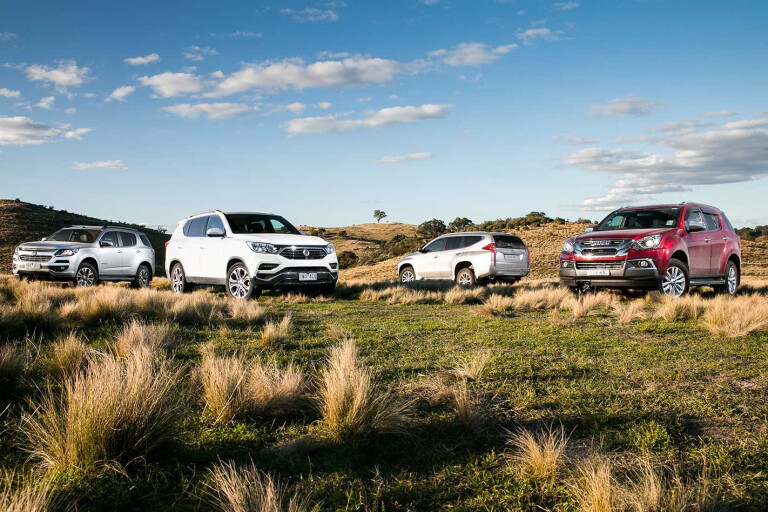
THE ute-based half-brothers, Holden Trailblazer and Isuzu MU-X, as well as the ute-based Mitsubishi Pajero Sport, are joined here by a new face in the segment, the SsangYong Rexton; although ,one that’s not without some family connection in Australia.
SsangYong first appeared here in 1996 when its Musso wagon was sold out the side-door of Mercedes-Benz dealers, before Daewoo took over its fellow Korean carmaker shortly after. However, that ended when Daewoo went broke in 1999. SsangYong then came via third-party distributors, before evaporating locally a few years ago.
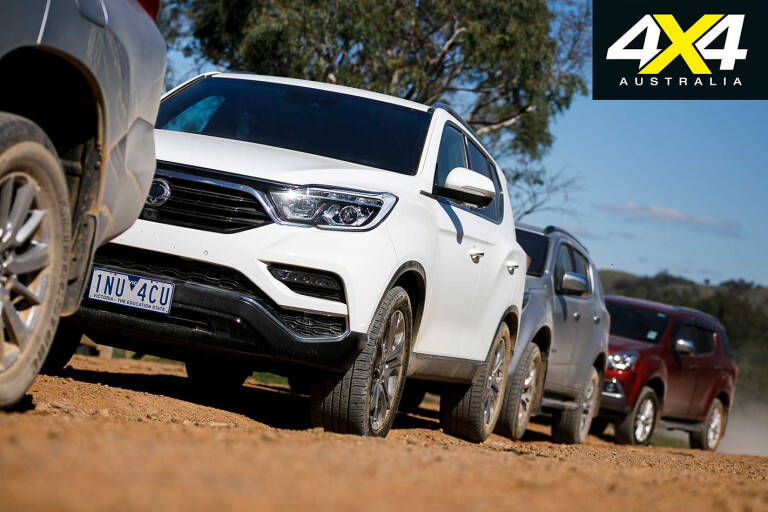
As of 2018, SsangYong has set up a factory-owned and backed distributor here in Australia, which is good news to potential buyers. The Rexton is one of a number of new SsangYong models and is pitched into a market where wagons built off utes are the norm – just like the Toyota Fortuner, Ford Everest and the other three vehicles here.
The Rexton also shares much with SsangYong’s own ute, the Musso, but it stands out in this company – and in the class in general – with independent rather than live-axle rear suspension. Perhaps, more importantly, the Rexton offers more equipment than anything in its class while costing less.
So how does the Rexton compare to the sales leaders in this class – MU-X and Pajero Sport – and to the somewhat underrated and much slower-selling Trailblazer? We test them off- and on-road to find out.
Holden Trailblazer LTZ - General Quarters
The Trailblazer may be a global GM design, but it still relies on a good deal of local engineering know-how.
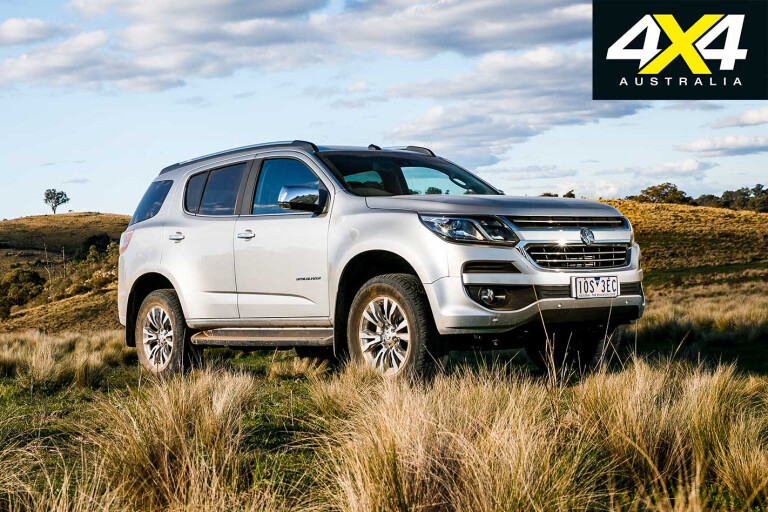
HOLDEN’S Trailblazer arrived in 2017 and was a top-to-bottom re-engineering of the Colorado 7, a wagon based off the all-new Colorado ute that arrived in 2012.
The Trailblazer, like the Colorado 7 and the current Colorado, is very much a global GM design, drawing in elements from Europe, North and South America, South-East Asia and Australia, but it has even more Australian input than the Colorado 7 and is better off for it.
As a wagon based on a ute, the predicable elements are there: a powertrain and front suspension carried over from the donor ute, essentially the same ladder frame but with a shorter wheelbase, and coil springs and disc brakes at the rear instead of leaf springs and drums.
Powertrain & Performance

THE Trailblazer’s 2.8-litre four-cylinder diesel, the second biggest engine here, comes from Italian diesel specialist VM Motori, once part-owned by General Motors.
There’s now more GM input into the engine thanks to the 2017 (Colorado 7 to Trailblazer) upgrades that fattened out the power delivery and more importantly brought smoother and quieter running. In this company, though, the 2.8 is noisier than the Rexton and the Pajero Sport, and even noisier at times than the MU-X.
It’s also the strongest engine here and one that lives up to the promise of its on-paper 147kW/500Nm claim. Pedal-to-metal it will see off the other three and, while it thrives on revs more than the Isuzu’s bigger and lazier engine, it’s not as revvy as the smaller diesels in the Pajero Sport or the Rexton.
Top marks also to the Trailblazer’s responsive and pro-active six-speed GM automatic, the sportiest gearbox here even if others shift more smoothly.
On-road ride & handling
.jpg )
THE Trailblazer also stands out in this company with its electric power steering (EPS), another of the changes that came with the Colorado 7 to Trailblazer rebirth. Its EPS makes for very light wheel twirling when parking or manoeuvring, but firms up nicely at highway speeds and provides a positive feel that’s as good if not better than
any other wagon here.
Handling is tidy, too, and there’s a generally smooth, quiet and compliant ride on most roads; another improvement over the Colorado 7. The suspension is certainly better sorted than the closely related MU-X and is well ahead of the Rexton.
Off-road
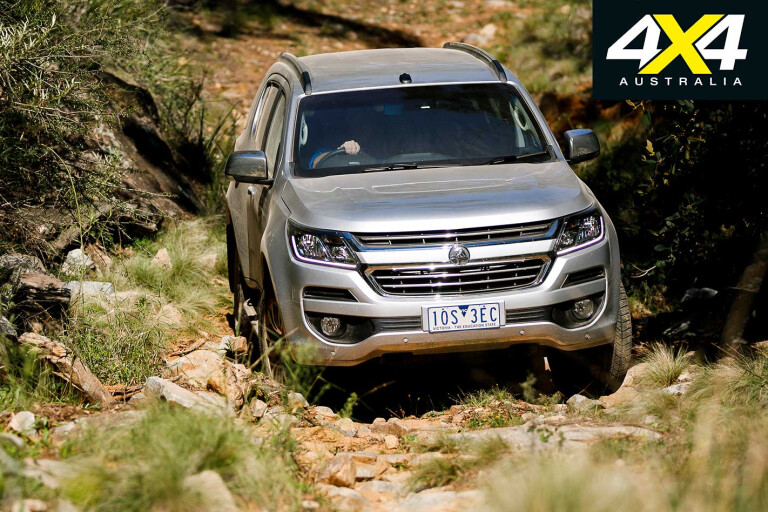
JUST AS the Trailblazer’s on-road demeanour is much improved, so too is its off-road ability thanks to an off-road specific recalibration of the electronic traction control that was part of the name-change re-engineering. This is the key point that makes the Trailblazer better than the otherwise similar MU-X, with which it shares most other things that define how they perform off-road (which for the both of them is generally better than the other two).
Even if it’s as good as it gets in this company off-road, the Trailblazer isn’t over endowed with suspension travel, nor does it have a rear locker; so its effective traction control system is the key element in getting it through difficult going that will strand the other three here.
Cabin, Accommodation & Safety
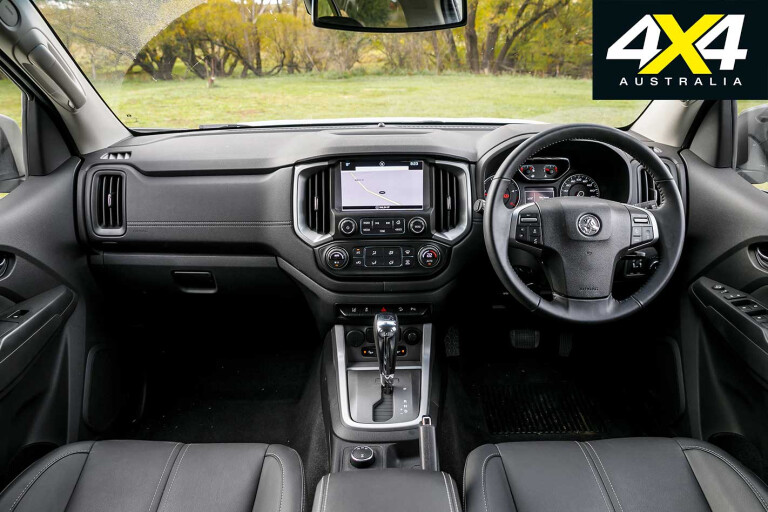
THE Trailblazer sits midfield in this class with its cabin space. It’s bigger than the Pajero Sport but smaller than the Rexton and, of course, matches the MU-X with which it shares the same basic body shell. It’s spacious and comfortable up front, but there’s no steering wheel reach adjustment for the driver.
Second-row seat space also matches MU-X and betters the Pajero Sport, but it’s a bit tighter than the spacious Rexton. Access to the third-row is easy enough and there’s even room for adults at a squeeze.
The way the Trailblazer’s (and MU-X’s) third-row seats fold makes for a high cargo floor and, annoyingly, there are only two cargo hooks at the rear of the luggage space and none at the front. When the third-row seat is in place there’s also very little luggage space left, all of which mirrors the MU-X.
Being an LTZ our test vehicle had the luxury of leather and heated front seats, with electric adjustment for the driver. It comes with a five-star ANCAP safety rating, as well as a good deal of advanced safety kit on top of that.
Practicalities

THE Trailblazer has the biggest fuel tank here but isn’t quite as thrifty on fuel as the MU-X or the Rexton, which means it finishes second on range – around 600km, given our test fuel use (11.6L/100km) and a 50km ‘safety’ allowance.
The Trailblazer’s standard 265/60R18 wheel and tyre package is common to many new 4x4s (Hilux included) so there’s a wide aftermarket tyre choice. You can also fit the 17s off the LT for an even wider and more off-road practical tyre choice.
The Trailblazer’s 3000kg tow rating matches the others bar the 3100kg of the Pajero Sport, but heavy-duty towing experience with the Colorado would suggest the Trailblazer’s powertrain would be the best for towing performance in this company.

HOLDEN TRAILBLAZER LTZ SPECS:
Engine: 2.8-litre 4-cyl turbo diesel
Max Power: 147kW @ 3600rpm
Max Torque: 500Nm @ 2000rpm
Gearbox: Six-speed automatic
4x4 System: Dual-range part-time
Crawl Ratio: 36.4:1
Construction: Separate-chassis
Front Suspension: Independent/coil springs
Rear Suspension: Live axle/coil springs
Wheel/Tyre: 265/60R18 110T
Kerb Weight: 2203kg
GVM: 2820kg
Payload: 617kg
Towing Capacity: 3000kg
Ground Clearance (claim): 218mm
Approach Angle: 26.0°
Ramp-over Angle: 22.0°
Departure Angle: 25°
Wading Depth: 600mm
Fuel Tank Capacity: 76 litres
ADR Fuel Claim: 8.2L/100km
Test Fuel Use: 11.6L/100km
HOLDEN TRAILBLAZER PRICES*
LT: $47,990
LTZ: $52,490
Z71: $53,490
*Prices do not include government or dealer charges.
What you get
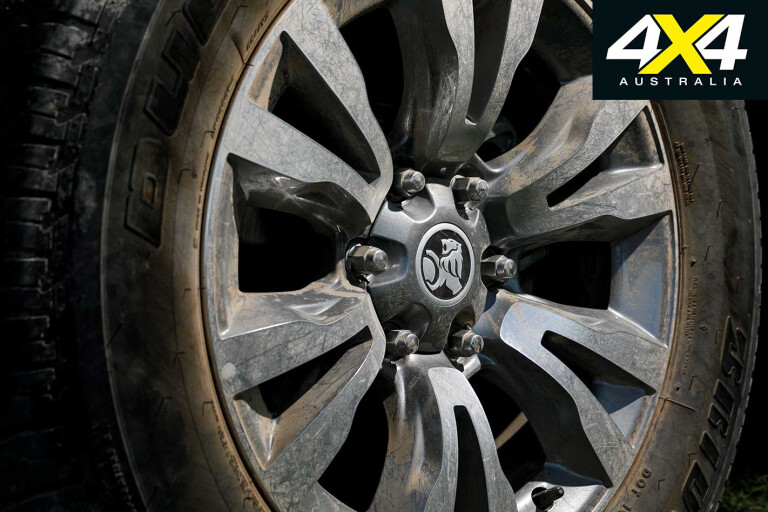
ALL Trailblazer models from the LT up get seven airbags, a reversing camera, rear-parking sensors, a seven-inch touchscreen, Apple CarPlay, Android Auto and LED DRLs. T
he LTZ adds to that with leather, sat-nav, front parking sensors, climate control air conditioning, rain-sensing wipers, tyre-pressure monitoring and a host of safety features including forward collision alert, blindspot monitoring, lane-departure warning and rear cross-traffic alert. The LTZ also swaps to an eight-inch touchcreen and 18s.
The Z71 then adds largely cosmetic enhancements including black-finished wheels, body mouldings, mirrors and door handles.
What's in a name?

IN ITS first iteration the Trailblazer was called the Colorado 7, simply because it was a seven-seat wagon based on the Colorado ute. But in creating the Trailblazer, Holden did a lot more than changing the name, as the Colorado 7 was stripped right down to its last nut and bolt before being put back together again with a large number of new and revised parts.
The changes addressed engine NVH, the feel and response of the automatic gearbox, the steering, ride and handling, cabin noise, interior fit and finish, and off-road performance, effectively providing a whole new driving experience.
Isuzu MU-X LS-T - Tough Stuff
The MU-X’s class-leading sales are built on its reputation for reliability and low running costs.
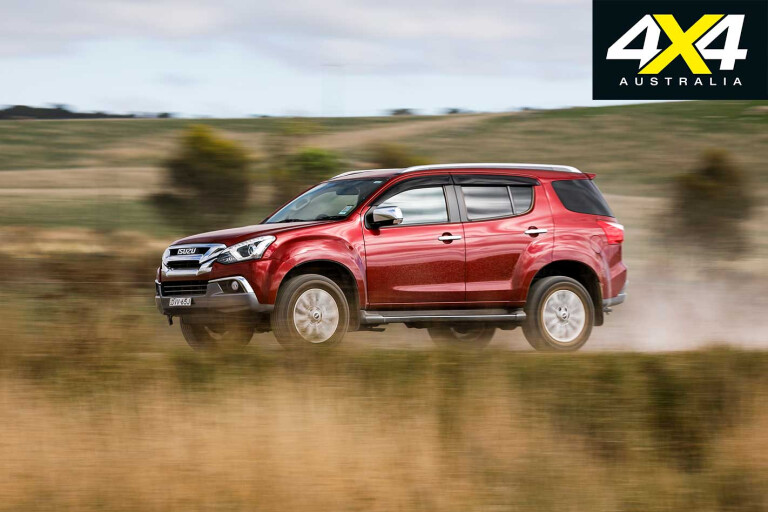
AS LUCK would have it, the MU-X you see here is the just-superseded 2018 MU-X, the new 2019 model being announced after we locked in this car for this comparison. Fortunately, there’s not much in it beyond a new grille, black-faced wheels and interior touches; although, Isuzu says the steering is tweaked to make it lighter at parking speeds.
This latest makeover follows close behind a number of upgrades to the MU-X in recent times. Arriving in Australia in late 2013 and remaining largely unchanged for three years, the MU-X gained a significantly updated engine, new six-speed automatic and manual gearboxes, NVH enhancements and additional equipment in early 2017.
A few months later there was a refreshed front-end styling, a new dash, more NVH control measures and additional equipment, while trailer-sway control was added for 2018.
Powertrain & Performance

THE MU-X’s 3.0-litre four-cylinder diesel is the latest iteration of an engine that effectively dates back to 2005. The most recent upgrade to comply with Euro 5 emission standards in 2017 brought a variable-geometry turbocharger, higher pressure common rail injection, revised pistons and a diesel particulate filter. Fortunately the changes also bring more torque over a wider rpm range, even if maximum power remained at 130kW.
Despite having the biggest capacity engine the MU-X can’t match the Trailblazer for performance and is back with the Pajero Sport and Rexton performance-wise, both of which have notably smaller engines.
However, in general driving, the MU-X’s engine needs less revs to do the same job as these two smaller engines. Its general, light-throttle running refinement is also very good, but when worked hard it’s also the least refined engine here.
For its part the MU-X’s six-speed auto offers reasonably smooth and well-timed shifts but isn’t as slick as the Rexton’s seven-speed or the Pajero Sport’s eight-speed, or as proactive in its shifting as the Trailblazer.
The overall gearing is also the tallest here, thanks in part to the six-speed auto – an Aisin gearbox shared with Hilux and Prado – having two very tall overdrive gears, which can induce shuffling back and forth between fifth and sixth on undulating country roads.
On-road ride & handling

OUR test MU-X felt as if it had done a lot more than the 9500km on the odo in terms of suspension damping control. Perhaps this particular car had done something arduous in its short life? Still, the ride quality and compliance was good, as was general handling amongst this four.
However, the MU-X isn’t as nippy as the Pajero Sport nor as generally well sorted as the Trailblazer, especially with regards to steering feel. We know this from previous experience, so it’s not just a reflection of this particular MU-X.
The MU-X’s 2019 upgrade promises lighter steering at parking speeds, and a little bit more feel at highway speeds wouldn’t go astray either.
Off-road
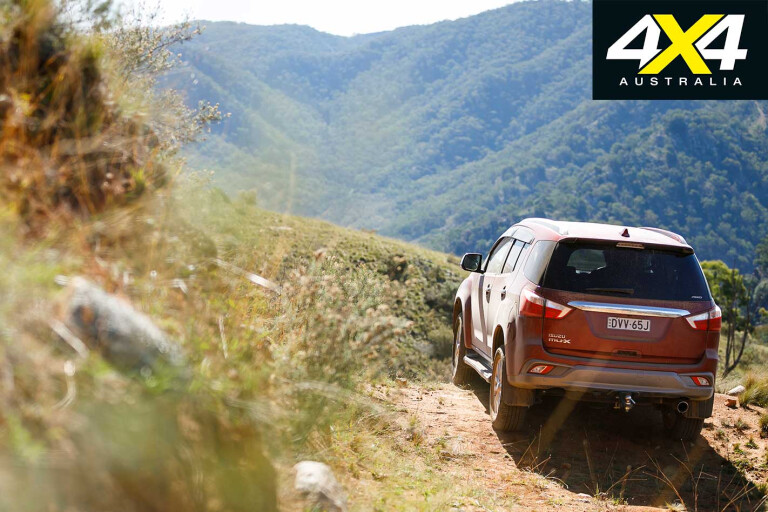
THE MU-X offers decent clearance and good vision for the driver when off-road, and it’s well protected underneath. In this company – which doesn’t set the bar too high as none have notably long-travel suspension – the MU-X does better than the Rexton and the Pajero Sport, even if the Trailblazer betters it thanks to its more effective traction control system which helps counter the modest amount of wheel travel of this shared platform.
While the MU-X is competent enough for most recreational off-road touring with nothing more than change of tyres, a rear locker would be a useful aftermarket upgrade, as would a rear recovery point. As is the case with Trailblazer, recovery points are only fitted at the front.
Cabin, Accommodation & Safety
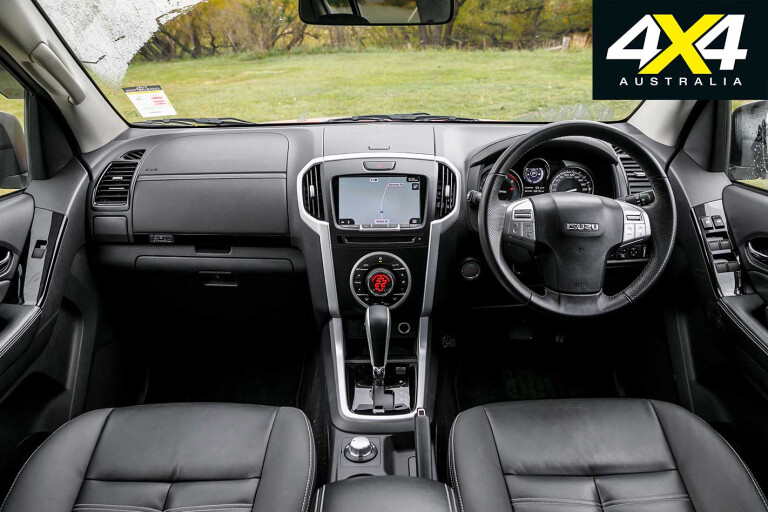
SMART-KEY entry (on this top-spec LS-T) and a conveniently placed grab handle make it easy to climb aboard to what is a generally comfortable and spacious driving position, electric-adjust leather seat and all. That said, our tallest test driver found it hard to get comfortable in both the MU-X and the Trailblazer, with which it shares cabin structure and lack of steering wheel reach adjustment.
The back seat is a bit of a squeeze for three adults (two adults and a child is more ideal) but is more spacious than the Pajero Sport and matches the Trailblazer. The third-row seats are easy to deploy and can seat adults, even if foot room could be better.
As with the Trailblazer, the third-row seats come at the cost of reduced luggage space with the high floor they create. Like the Trailblazer, there aren’t any tie-down points located on the cargo floor.
The MU-X’s fit and finish and general cabin presentation is much improved by pre-2017 standards, but it isn’t up to the standard of the flashier Pajero Sport or even the Rexton.
Thanks in part to six airbags the MU-X offers five-star ANCAP safety, and as of 2019 comes with features such as blind-spot monitoring, rear cross-traffic alert and front parking assistance as extra-cost factory accessories.
Practicalities
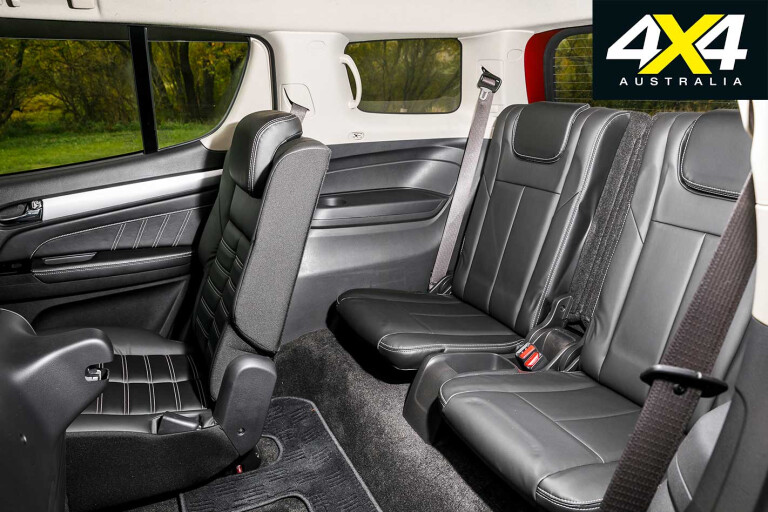
THE MU-X has the smallest fuel tank here, its 65 litres being 11 litres shy of the 76 litres of the Trailblazer. However, as always with the MU-X (and the D-Max), the 3.0-litre engine is thrifty, so the overall fuel range is still competitive.
As part of the 2019 update the warranty was bumped up to six years (or 150,000km) the roadside assistance was increased to six years, and the fixed-price servicing stretched to seven years (or 105,000km).
The MU-X’s tow rating of 3000kg is typical of this class and, while we haven’t towed with the MU-X, the identical powertrain in the D-Max does a respectable job of heavy duty towing.
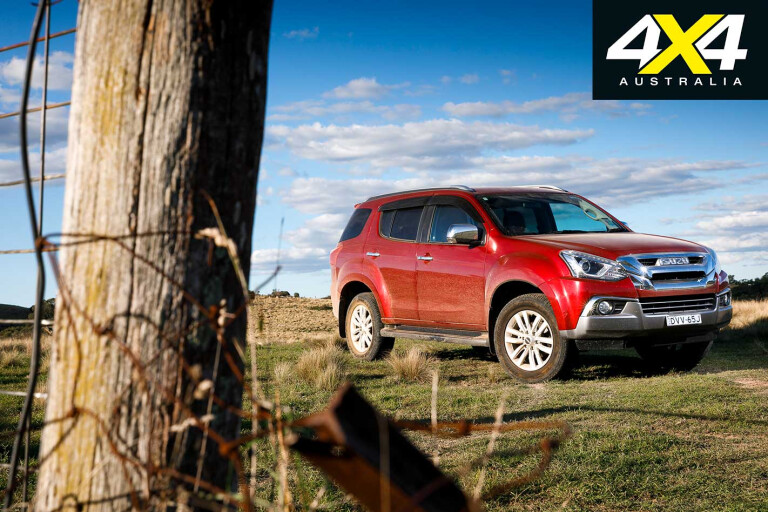
ISUZU MU-X LS-T SPECS:
Engine: 3.0-litre 4-cyl turbo diesel
Max Power: 130kW @ 3600rpm
Max Torque: 430Nm @ 2000-2200rpm
Gearbox: Six-speed automatic
4x4 System: Dual-range part-time
Crawl Ratio: 33.3:1
Construction: Separate-chassis
Front Suspension: Independent/coil springs
Rear Suspension: Live axle/coil springs
Wheel/Tyre: 255/60R18 108S
Kerb Weight: 2157kg
GVM: 2750kg
Payload: 593kg
Towing Capacity: 3000kg
Ground Clearance (claim): 230mm
Approach Angle: 24.0°
Ramp-over Angle: 19.5°
Departure Angle: 25.1°
Wading Depth: 600mm
Fuel Tank Capacity: 65 litres
ADR Fuel Claim: 7.9L/100km
Test Fuel Use: 10.4L/100km
ISUZU MU-X PRICES*
LS-M: $50,200
LS-U (M/T): $50,400
LS-U (A/T): $52,400
LS-T: $56,200
*Prices do not include government or dealer charges.
What you get
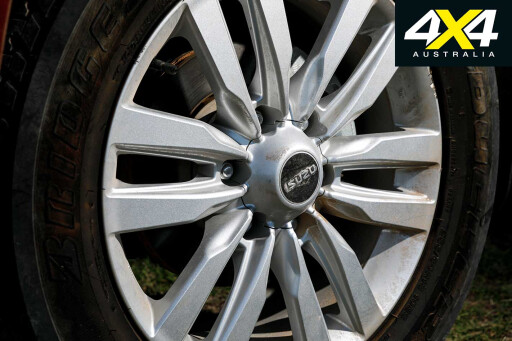 ALL MU-X models from the LS-M up get six airbags, a seven-inch touchscreen, Bluetooth, USB input, a reversing camera, LED DRLs and headlights, and trailer-sway control. The LS-U then adds an eight-inch touchscreen, sat-nav, climate control, air-con outlets for the rear-seat passengers, fog lights, side-steps, rear privacy glass and 18s in place of the LS-M’s 16s.
ALL MU-X models from the LS-M up get six airbags, a seven-inch touchscreen, Bluetooth, USB input, a reversing camera, LED DRLs and headlights, and trailer-sway control. The LS-U then adds an eight-inch touchscreen, sat-nav, climate control, air-con outlets for the rear-seat passengers, fog lights, side-steps, rear privacy glass and 18s in place of the LS-M’s 16s.
The LS-U is also the only model that comes with the option of a manual gearbox. The LS-T then adds ‘smart-key’ entry and start, leather seats with electric-adjust for the driver, rear DVD entertainment, roof rails and tailgate spoiler. Isuzu also now offer blindspot monitoring, rear cross-traffic alert and front parking assistance as an extra-cost accessory on all MY17 and later MU-X models.
What's in a name?
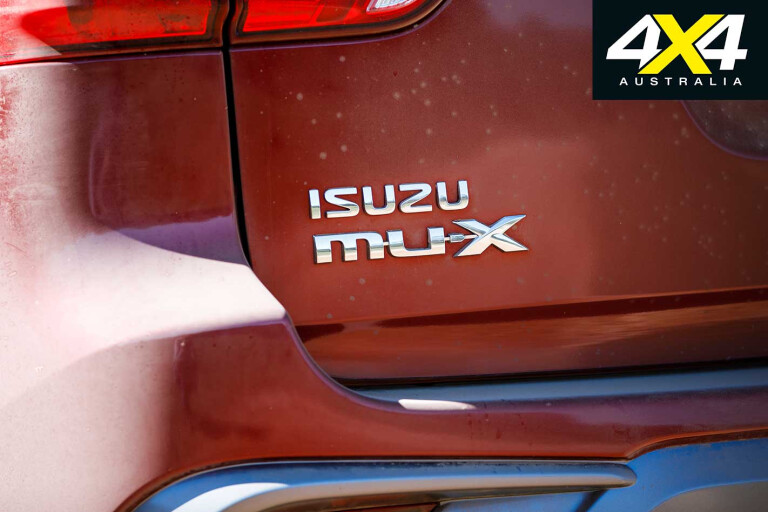
YOU might think Isuzu is relatively new to Australia as the brand only appeared here in its own right in 2008, but Isuzu vehicles have been around in Australia since the mid 1970s wearing Holden badges such as Gemini, Rodeo, Jackaroo and the now long-forgotten Frontera, sold elsewhere in the world as the Isuzu MU and the forebear of today’s MU-X.
Mitsubishi Pajero Sport - Triton Sport, anyone?
Despite the name, there’s no Pajero in the Pajero Sport … it’s all Triton.

MITSUBISHI has been building a wagon based on a Triton ute since 1996, sold here as the Challenger. In some parts of the world it was called a Pajero Sport right from the get-go, but that name was only adopted here in 2015 when this model arrived off the back of the then-new Triton.
Initially the Pajero Sport was only available as a five-seater, but third-row seats were introduced on mid- and top-spec models the following year. The Pajero Sport’s latest update – for the 2018 model year – has seen automatic emergency braking and radar cruise control, features previously exclusive to the top-spec Exceed model, become standard across the range.
What we are driving here is a base-spec GLX; although, it doesn’t present as a ‘budget’ model, even if there’s no third-row seating, a unique feature of the class and possibly one reason behind its strong sales. Not everyone – especially older buyers with grown-up families – needs seven seats.
Powertrain & Performance

THE Pajero Sport shares the same 2.4-litre four-cylinder diesel as the Triton, an all-new engine in 2015. It boasts Euro 5 compliance and comes with the now ubiquitous diesel particulate filter, which is what’s generally needed to bridge the gap from Euro 4 to Euro 5.
The 2.4 is a modern design with relatively low compression ratio (for refinement and lower NOx) and, surprisingly for a relatively small capacity four, it employs counter-rotating balance shafts for improved smoothness. On the road the engine delivers on this promise of modernity and is quiet, smooth and refined, bettered only by the Rexton in this company in that regard.
Despite its smaller capacity it claims the same maximum torque (430Nm) as the 3.0-litre in the MU-X and a little more power (133kW v 130kW), but this doesn’t translate to any performance advantage. Nor does its 2.4-litre capacity make it any better off than the 2.2-litre engine in the Rexton, as it too claims 133kW.
Unlike the MU-X and the Trailblazer, the Pajero Sport doesn’t share the gearbox of its donor ute, previously a five-speed automatic but now a six-speed automatic. Instead the Pajero Sport gets a slick Aisin eight-speed automatic complete with paddle shifters, even on this base-spec GLX.
On-road ride & handling

THE Pajero Sport stands alone in this company with its ‘Super Select’ 4x4 system that allows the driver to select 4x4 on any road surface, sealed or unsealed, wet or dry, and leave it there. It’s effectively a full-time 4x4 system but you still have the option of two-wheel drive. The other three wagons here have part-time 4x4, a relatively rudimentary, less convenient and less safe system.
This alone gives the Pajero Sport a ‘sporty’ edge in this company, also helped by the fact it’s the smallest vehicle here and generally feels more agile in the way it handles. A nicely connected feel to the steering also helps, especially in comparison to the MU-X and the Rexton.
Off-road
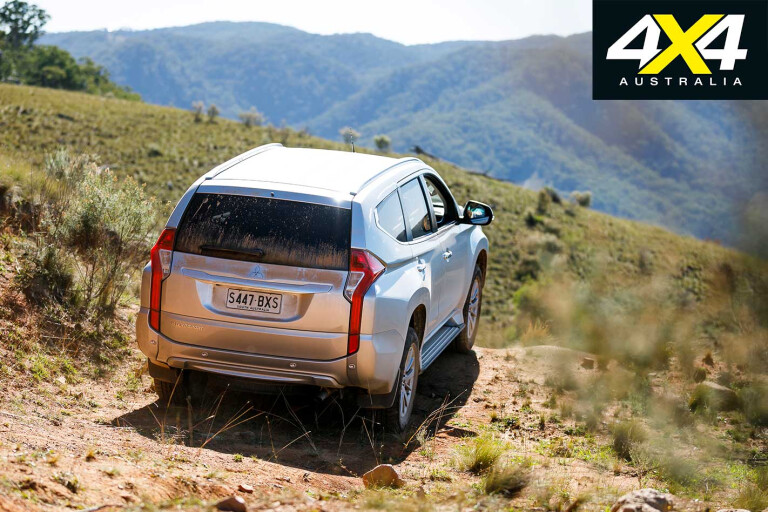
AS WITH the other three wagons here the Pajero Sport isn’t overly endowed with wheel travel and, while better than the Rexton, it can’t quite match the Trailblazer and MU-X half brothers, which still don’t have the wheel travel or the off-road ability of more sophisticated wagons such as Toyota’s Prado and Ford’s Everest.
The Pajero Sport’s electronic traction control isn’t notably effective, either, and while mid- and top-spec models have a driver-switched rear diff-lock, engaging the locker cancels the electronic traction control on both axles so it’s not always a benefit.
The Pajero Sport is still a bit more manoeuvrable and handy in tight spots than the bigger wagons here, and it’s the only one with front and rear recovery points.
Cabin, Accommodation & Safety

THE Pajero Sport’s cabin is smaller than the other three wagons, something you notice up front and in the second row. The GLX, as tested here, only has two rows of seats but comes out on top in terms of luggage space as a result. It’s also the only one of the three with floor-mounted cargo tie-downs.
Taller drivers may find the driving position a bit cramped, especially for lateral legroom given the wide centre console, but everyone benefits from the steering wheel’s tilt and reach adjustment, something missing in the MU-X and Trailblazer. Good front seats, too.
The Pajero Sport has a five-star ANCAP safety rating and all models have automatic emergency braking, while the Exceed gets blind-spot monitoring.
Practicalities
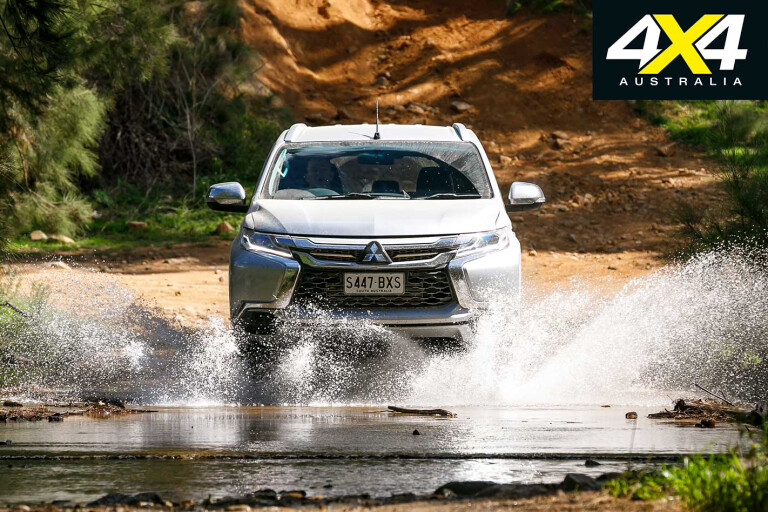
THE Pajero Sport has a 68-litre fuel tank, the second smallest tank here, but on test it had the shortest range given its higher fuel use.
The Pajero Sport has a nominally higher tow rating than the Trailblazer and the MU-X (by 100kg), but if experience with the same powertrain in the Triton is anything to go by that theoretical advantage would evaporate on the road.
The Pajero Sport offers a five-year warranty, four-year roadside assistance, three-year capped-price servicing and 15,000km/12-month service intervals.
MITSUBISHI PAJERO SPORT GLX SPECS:
Engine: 2.4-litre 4-cyl turbo diesel
Max Power: 133kW @ 3500rpm
Max Torque: 430Nm @ 2500rpm
Gearbox: Eight-speed automatic
4x4 System: Dual-range full-time (plus 2WD)
Crawl Ratio: 45.9:1
Construction: Separate-chassis
Front Suspension: Independent/coil springs
Rear Suspension: Live axle/coil springs
Wheel/Tyre: 265/60R18 110H
Kerb Weight: 2045kg
GVM: 2710kg
Payload: 655kg
Towing Capacity: 3100kg
Ground Clearance (claim): 218mm
Approach Angle: 30.0°
Ramp-over Angle: 23.1°
Departure Angle: 24.2°
Wading Depth: 700mm
Fuel Tank Capacity: 68 litres
ADR Fuel Claim: 8.0L/100km
Test Fuel Use: 11.7L/100km
MITSUBISHI PAJERO SPORT PRICES*
GLX (five seat): $46,490
GLS (five seat): $49,990
GLS (seven seat): $50,990
Black Edition (seven seat): $52,240
Exceed (seven seat): $54,490
*Prices do not include government or dealer charges.
What you get

ALL Pajero Sport models get ‘smart’ key entry and start, seven airbags, tilt and reach steering wheel adjustment, digital radio, hill-descent control, a selectable ‘Off-Road’ mode, rear parking sensors, a reversing camera, trailer sway control, automatic emergency braking and adaptive cruise control, LED headlamps and DRLs, and ride on 18s.
The GLS adds dual-zone climate, leather, electric seat adjust for driver and passenger, six speakers (up from four), auto headlights and wipers, a rear locker and the option of third-row seats.
The top-spec Exceed then adds heated front seats, headlight washers, two additional audio speakers, blindspot monitoring, a tailgate spoiler and third-row seats as standard.
What's in a name?

IT MAY be called a Pajero Sport, but Triton Sport would be a more accurate name given the Pajero Sport shares nothing with the Pajero and much with the Triton ute upon which it is based. Being ute-based the Pajero Sport has separate-chassis construction and a rear live axle whereas the Pajero is a world away with its monocoque construction and fully independent suspension.
Ironically, the Pajero Sport is less sporty to drive than the Pajero with its Dakar Rally DNA.
Ssangyong Rexton Ultimate - Left Field
The SsangYong Rexton stands out in this company in more ways than one…
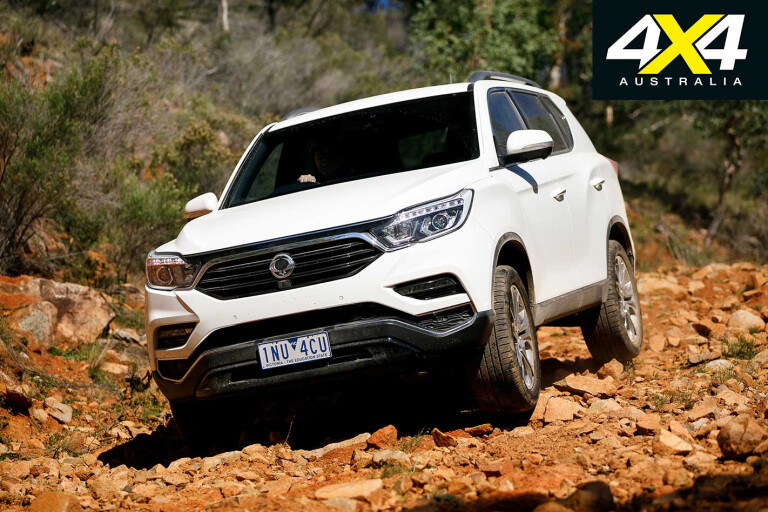
THE Rexton is one of several models introduced into Australia by a born-again SsangYong, but it shares little with the Rexton that was sold here from 2003 to 2012 and elsewhere up to 2017 before being replaced by the all-new model you see here.
This new Rexton comes off the back of investment in SsangYong by Mahindra, who has owned SsangYong since 2011. This new model will be also rebadged as Mahindra Alturas G4 for the Indian market.
Like the other three vehicles here it is built off a separate chassis (it shares a platform with SsangYong’s Musso ute) but unusually features coil-sprung independent suspension at the rear rather than a coil-sprung live axle you’ll find beneath all the other vehicles in this class, including the other three here.
The Rexton also shares the Musso’s 2.2-litre diesel but in a slightly higher state of tune, swaps the Musso’s six-speed automatic for a seven-speed auto, and retains the Musso’s dual-range part-time 4x4 system. What we have here is top-spec Ultimate, which sells for $52,990 driveaway despite lavish standard equipment. That means a good deal less money for a vehicle that’s better equipped than the others here.
Powertrain & Performance
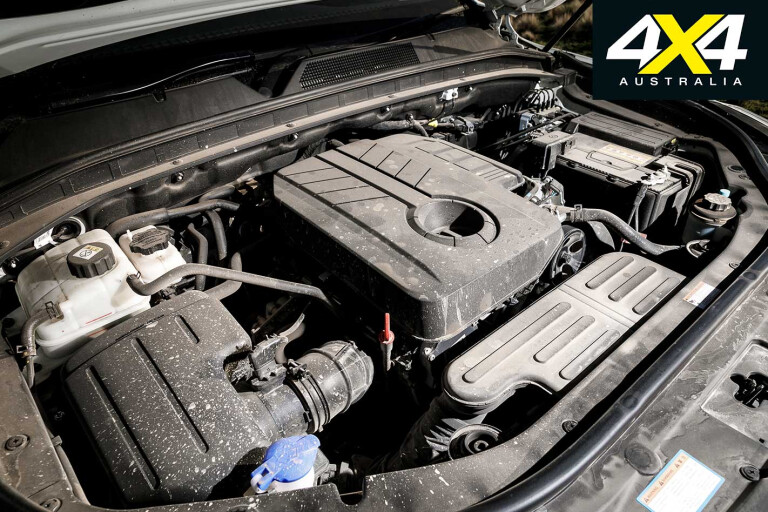
THE Rexton’s 133kW/420Nm 2.2-litre diesel is the smallest here but makes more power – on paper at least – than the biggest engine here, the MU-X’s 3.0-litre. It does this without the benefit of multiple turbos as it’s a single-turbo design.
Its 420Nm figure is also good for the engine capacity and is available from just 1400rpm. By comparison, the next smallest engine here, the 2.4 on the Pajero Sport, makes just 10Nm more but needs another 1100rpm to do so.
On the road the Rexton’s ‘little’ engine lives up to this on-paper promise and overcomes the burden of powering the heaviest vehicle here to produce performance that’s competitive with the MU-X and the Pajero Sport. It’s still outdone by the Trailblazer, but so too are the two others.
The Rexton’s engine is a clear winner in this company for refinement. It’s quieter and smoother than either the MU-X or the Trailblazer engines and even betters the reasonably refined Pajero Sport engine. Very good economy, too – the best on test, even if there wasn’t much between it and the MU-X.
The seven-speed auto, a Mercedes-Benz design, is also an impressively smooth and slick-shifting gearbox that’s as good if not better than any here in terms of shift quality. Not so good is the ‘manual shift’ via the fiddly flick-switch on the side lever.
On-road ride & handling
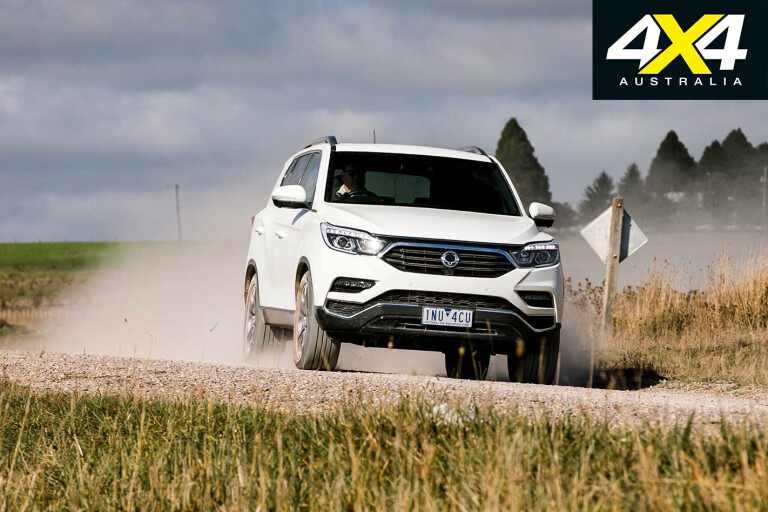
YOU’D expect the Rexton to ride and handle differently to the three live-axle vehicles here given its independent rear suspension (IRS), and it does. On paper the IRS gives a significant advantage over a live-axle design, and on most roads at modest speeds the Rexton feels more composed and compliant than the others here, thanks not only to its IRS but also the fact its more softly sprung and dampened.
Not so good is the sharp edge to the ride on some surfaces due to the 20-inch wheels and low-profile tyres fitted to this top-spec Ultimate. We have previously tested an ELX model (2019 4x4OTY) and found it rode much better on the 18s with their taller tyres.
Push the Rexton harder on bumpier roads and the soft springing and dampening sees handling start to unravel, while the very light steering lacks precision and feel at higher speeds on poor roads.
Off-road

THE Rexton’s independent rear suspension, which is a theoretical advantage on-road, is also an off-road negative. Add in the fact there’s not much travel at either end and that electronic traction control isn’t notably effective, and the Rexton works harder than the other vehicles on more difficult off-road tracks.
Further compounding the Rexton’s off-road limitations is that it has the least ground clearance and the poorest over-bonnet visibility of the four. The all-or-nothing throttle calibration in low range can also be a problem.
The Rexton is the only vehicle here that doesn’t draw its engine intake air from the inner mudguard (not so good for deeper water crossings) and the only one without fixed recovery points; although, it does have a screw-in towing eye that can be mounted front or rear. While it goes without saying, the Ultimate’s 20s aren’t what you want off-road.
Cabin, Accommodation & Safety
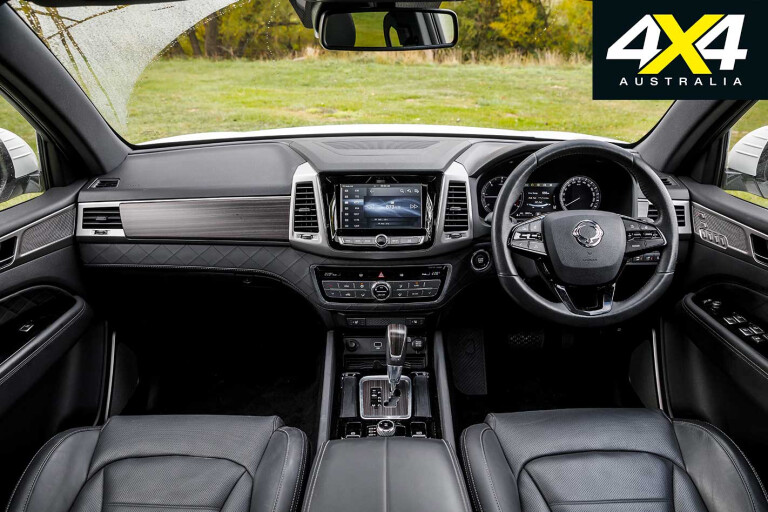
THE Rexton has the biggest cabin here and a roomy and comfortable driving position, which is arguably the best here too thanks in part to its tilt and reach steering wheel adjustment.
The cabin looks to come from a much more expensive vehicle, with features such as heated and cooled front seats and heated second-row seats. It’s definitely the most lavishly equipped here, and the general fit and finish is also good even if the presentation is busy.
The Rexton has the roomiest rear seat with plenty of room for tall adults sitting behind a tall driver or front-seat passenger. There’s less joy in the third row, which lacks leg and foot room.
The Rexton hasn’t been ANCAP tested at this stage but has received a five-star rating in the equivalent Korean crash testing. All models get autonomous braking, tyre pressure monitoring, lane-departure, blind-spot warning and rear cross-traffic alert, which puts it at the front of the pack in terms of safety kit.
Practicalities
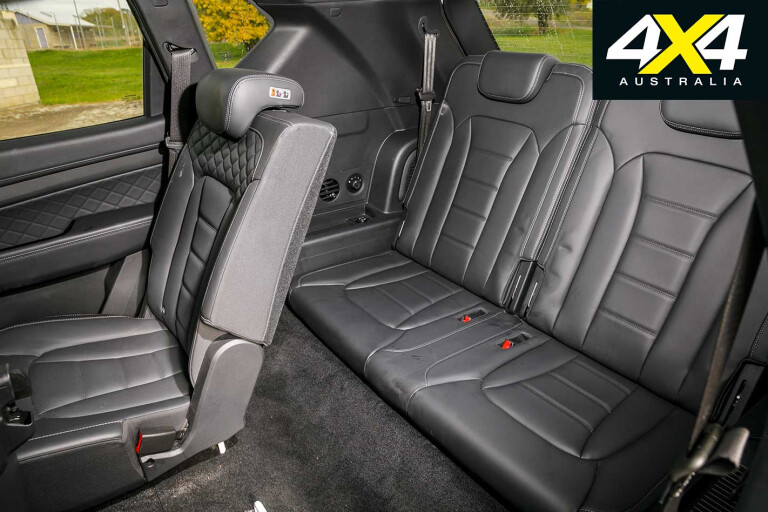
THE Rexton has a 70-litre tank, more than the MU-X or Pajero Sport but less than the Trailblazer. However, with the consumption recorded on this test, it has the longest fuel range.
The Rexton is rated to tow 3000kg, which is on par with the others, but its smaller engine and IRS may work against it when asked to tow that much. It also has the highest GVM, which helps give it the best on-paper payload of 727kg.
The standard 18-inch wheels carry a 255/60 tyre, but moving to a one-size-bigger 265/60s would open up a wide choice in all-terrain rubber in this common (Hilux, Prado, Ranger, etc.) size.

SSANGYONG REXTON ULTIMATE SPECS:
Engine: 2.2-litre 4-cyl turbo diesel
Max Power: 133kW @ 4000rpm
Max Torque: 420Nm @ 1400-2800rpm
Gearbox: Seven-speed automatic
4x4 System: Dual-range part-time
Crawl Ratio: N/A
Construction: Separate-chassis
Front Suspension: Independent/coil springs
Rear Suspension: Independent/coil springs
Wheel/Tyre: 255/50R20 105H
Kerb Weight: 2233kg
GVM: 2960kg
Payload: 727kg
Towing Capacity: 3000kg
Ground Clearance (claim): 224mm
Approach Angle: 20.5°
Ramp-over Angle: 20.0°
Departure Angle: 22.0°
Wading Depth: N/A
Fuel Tank Capacity: 70 litres
ADR Fuel Claim: 8.3L/100km
Test Fuel Use: 10.3L/100km
SSANGYONG REXTON PRICES*
ELX: $46,990
Ultimate: $52,990
*Prices are drive-away
What you get
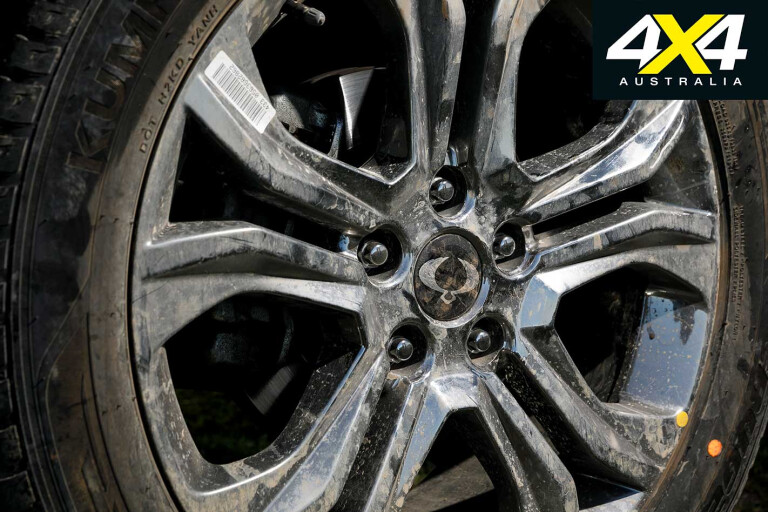
THE Rexton comes in three models but only two are diesel 4x4s, the third model being an entry-level petrol 4x2 ‘EX’ model. Both diesel models, starting with the ELX, come with autonomous braking, no fewer than nine airbags, heated and cooled seats, front seats with electric adjust, heated rear seats, third-row seats, tyre pressure monitoring, lane-departure, blind-spot warning and rear cross-traffic alert, an eight-inch touchscreen and smartphone connectivity.
The Ultimate than swaps the ELX’s 18s for 20s and adds a sunroof, power tailgate, rear A/C controls, a 360-degree camera and HID headlights.
What's in a name?
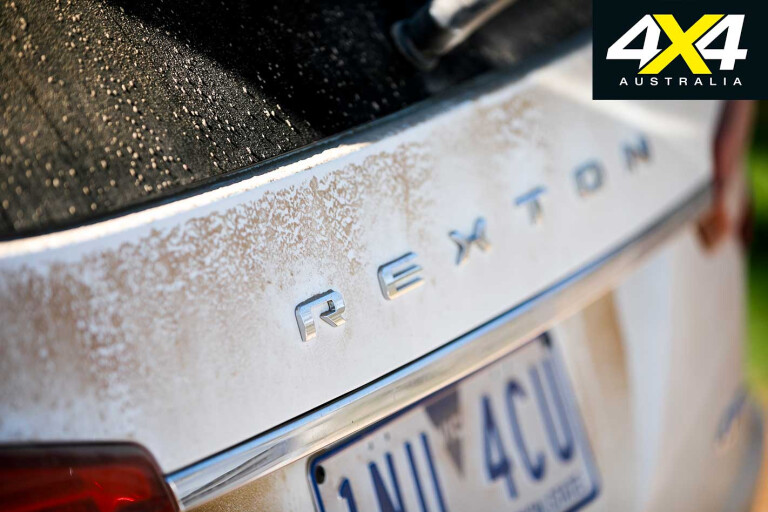
THE SsangYong name dates back to 1986, but SsangYong’s beginnings are in 1954. A merger of two smaller companies, it built trucks, buses, and military Jeeps under licence for the US Army during the 1960s.
With production expanding to fire-fighting equipment and specialist vehicles, the company was named Dong-A Motor in 1977 and acquired Keowha, which had been making Jeep CJ look-a-likes (the Korando) under licence.
The financial takeover by SsangYong Business Group in 1986 brought the current name and since then SsangYong has been acquired by Daewoo in 1977 (before it went bust) and then in 2004 by Chinese carmaker SAIC who sold it to India’s Mahindra in 2011, where it has since flourished.
The Verdict
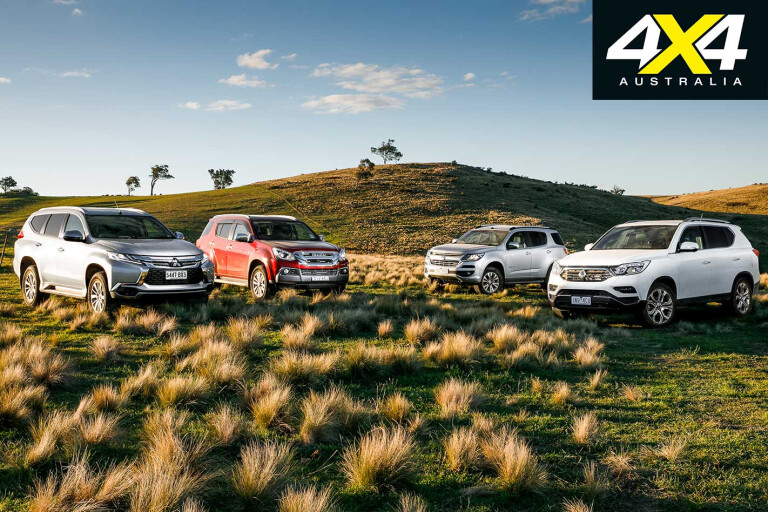
WITH THE testing completed and the dust settled, how do these four family 4x4 wagons shape up? Well, very closely. So close that it’s hard to pick a winner, even though the four are all very different and have contrasting pros and cons. What wins all depends on your priorities.
The Rexton offers the most kit for the least money by a good margin, as you can drive away in very well-equipped ELX for $46,990, which is what you pay for the base-spec five-seat Pajero Sport (the least expensive of the others) before stamp duty, registration and any dealer charges.
The Rexton is also the most spacious vehicle (it almost feels as if it’s in a bigger class), offers competitive performance and has the most refined engine. On many roads it’s also the most comfortable and the quietest. Not so good is its chassis performance on poor quality roads, or indeed the performance of the whole vehicle off-road. If you value 4x4 performance the Rexton is not what you want.
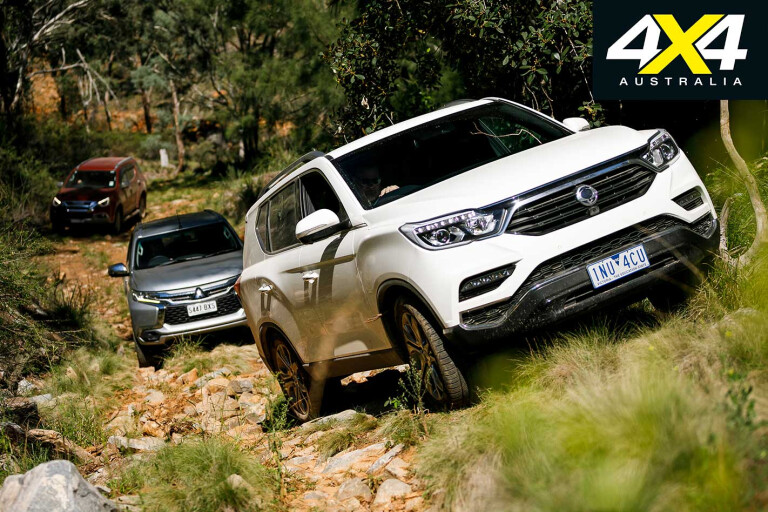
Nor would you buy the Pajero Sport for its off-road ability, for while it’s notably better than the Rexton its off-road prowess is still modest. Countering is the fact that it’s the sportiest drive on-road and comes with the convenience and safety of full-time 4x4, a game changer in mixed road and mixed weather touring conditions. If you don’t want third-row seats, the Pajero Sport is the only option.
You’ll be better off again off-road in the MU-X as it’s more than useful for general 4x4 recreational duties; although, it still isn’t as off-road capable out of the box as it could be. Best of all the MU-X offers a well-proven powertrain with low service and fuel costs that’s also happy to take on towing duties.
If off-road ability is your key criteria then the Trailblazer is the pick. It also offers the best engine performance and the chassis works nicely on the road. That’s probably enough to crown it the winner here, but that’s up to you.
Specifications

| Holden Trailblazer LTZ | Isuzu MU-X LS-T | Mitsubishi Pajero Sport GLX | Ssangyong Rexton Ultimate | |
| Engine | 2.8-litre 4-cyl turbo diesel | 3.0-litre 4-cyl turbo diesel | 2.4-litre 4-cyl turbo diesel | 2.2-litre 4-cyl turbo diesel |
| Power | 147kW @ 3600rpm | 130kW @ 3600rpm | 133kW @ 3500rpm | 133kW @ 4000rpm |
| Torque | 500Nm @ 2000rpm | 430Nm @ 2000-2200rpm | 430Nm @ 2500rpm | 420Nm @ 1400-2800rpm |
| Gearbox | 6-speed automatic | 8-speed automatic | 7-speed automatic | |
| 4x4 System | Dual-range part-time | Dual-range full-time (plus 2WD) | Dual-range part-time | |
| Crawl Ratio | 36.4:1 | 33.3:1 | 45.9:1 | N/A |
| Construction | Separate-chassis | |||
| Suspension (f) | Independent, coil springs | |||
| Suspension (r) | Live axle, coil springs | Independent, coil spring | ||
| Kerb Weight | 2203kg | 2157kg | 2045kg | 2233kg |
| GVM | 2820kg | 2750kg | 2710kg | 2960kg |
| Payload | 617kg | 593kg | 655kg | 727kg |
| Towing capacity | 3000kg | 3100kg | 3000kg | |
| Departure angle | 25.0° | 25.1° | 24.2° | 22.0° |
| Rampover angle | 22.0° | 19.5° | 23.1° | 20.0° |
| Approach angle | 26.0° | 24.0° | 30.0° | 20.5° |
| Wading depth | 600mm | 700mm | N/A | |
| Ground clearance | 218mm | 230mm | 218mm | 224mm |
| Fuel capacity | 76 litres | 65 litres | 68 litres | 70 litres |
| ADR fuel claim | 8.2L/100km | 7.9L/100km | 8.0L/100km | 8.3L/100km |
| Test fuel claim | 11.6L/100km | 10.4L/100km | 11.7L/100km | 10.3L/100km |
| Price | $52,490 | $56,200 | $46,490 | $52,990 |

COMMENTS